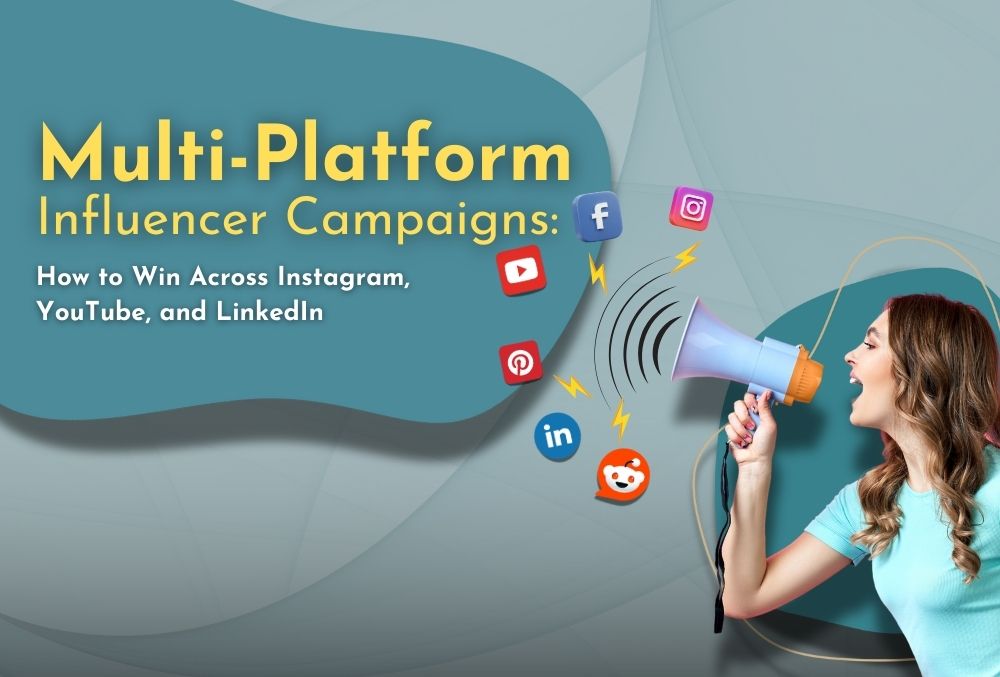This blog provides a comprehensive guide to building a powerful multi-platform influencer marketing strategy tailored to Instagram, YouTube, and LinkedIn—so you can drive higher ROI, deeper engagement, and measurable conversions across the board.
Why Multi-Platform Campaigns Matter in 2025
With attention spans shrinking and content formats evolving, today’s users jump between platforms effortlessly. A potential customer might see your product on Instagram, search for reviews on YouTube, and then check your industry authority on LinkedIn. In this landscape, single-platform influencer campaigns fall flat—they simply can’t cover the full digital buyer’s journey. That’s why in 2025, success lies in delivering tailored content across all key platforms simultaneously.
Brands that embrace a synchronized multi-platform strategy not only increase visibility but also build trust, establish authority, and improve conversion rates across the board.
Trends
The modern consumer’s journey spans multiple platforms. They might discover a brand on Instagram, watch a product review on YouTube, and validate the brand’s credibility through a LinkedIn post. In 2025, this cross-platform behavior is the norm, not the exception. That’s why having a multi-platform presence is no longer a competitive edge—it’s a necessity.
Strategic Insight
Each platform plays a distinct role in the buyer’s journey:
- Instagram is for discovery and engagement.
- YouTube drives trust through long-form, informative content.
- LinkedIn reinforces professional credibility and B2B influence.
Sociocreator’s Role
Sociocreator enables brands to streamline campaign execution across all major platforms—helping with influencer discovery, content planning, analytics, and seamless collaboration.
Understanding the Strengths of Each Platform

Instagram: Visual Storytelling & Brand Discovery
Use Cases: Ideal for product launches, building visual brand identity, and leveraging user-generated content.
Key Formats: Reels, Stories, Carousels, Branded Collaborations
YouTube: Long-Form Content & In-Depth Reviews
Use Cases: Best for tutorials, unboxings, and detailed product reviews.
Key Formats: YouTube Shorts, Vlogs, Sponsored Review Videos
LinkedIn: Professional Networking & Thought Leadership
Use Cases: Powerful for B2B marketing, sharing industry trends, and gaining endorsements from professionals.
Key Formats: Articles, Document Posts, Webinars, Industry Panels
Platform Role in the Buyer Journey

| Platform | Primary Role | Content Type | Best For |
| Brand Discovery | Reels, Stories, Carousels | Product launches, engagement | |
| YouTube | Trust & Consideration | Vlogs, Tutorials, Shorts | In-depth reviews, education |
| Professional Validation | Articles, Webinars | B2B marketing, thought leadership |
Crafting a Cohesive Cross-Platform Strategy
Audience Segmentation: Tailor content to the audience’s platform-specific expectations. For example, keep Instagram content fun and visual, while LinkedIn content should be insight-driven and professional.
Content Matrix Development: Map out formats, publishing cadence, and platform-specific tone. E.g., schedule 3 Reels/week on Instagram, 1 long-form video/month on YouTube, and 2 thought leadership posts/month on LinkedIn.
Platform Role Definition:
- Instagram = Awareness & Engagement
- YouTube = Trust & Education
- LinkedIn = Authority & Professional Validation
Selecting the Right Influencers for Each Platform
Instagram:
Focus on micro-influencers with niche communities and high engagement. Prioritize authenticity and alignment with your brand tone.
YouTube:
Partner with creators known for detailed content and loyal subscribers. Look for influencers with proven success in product explainers or tutorials.
LinkedIn:
Collaborate with professionals and thought leaders who have real industry experience and credibility. Ideal for B2B narratives and executive outreach.
Influencer Traits by Platform
| Platform | Ideal Influencer Traits | Engagement Focus |
| High engagement, authentic content | Visual storytelling, brand image | |
| YouTube | Niche authority, long-form expertise | Education, product reviews |
| Industry credibility, professional voice | Thought leadership, trust building |
Case Study: Successful Multi-Platform Campaign
Overview: A tech brand launched a new productivity app targeting entrepreneurs and SMEs. They used Instagram for lifestyle visuals, YouTube for tutorials, and LinkedIn for leadership interviews.
Results:
- 2.3x higher engagement compared to platform-only campaigns
- 30% increase in app downloads
- 42% lift in brand recall among professionals on LinkedIn
Common Pitfalls in Multi-Platform Campaigns

Content Duplication: Copy-pasting the same content across platforms doesn’t work. Customize visuals, language, and format.
Misaligned Messaging: Your brand tone must shift subtly to match the audience and platform without losing consistency.
Neglecting Analytics: Track KPIs per platform. What works on YouTube may not perform well on LinkedIn. Always evaluate separately and optimize accordingly.
Tools & Resources for Effective Campaign Management
Influencer Discovery: Use platforms like Sociocreator to identify high-performing creators tailored to each platform and industry.
Content Scheduling: Leverage tools like Later, Buffer, or Hootsuite to manage and automate posts across Instagram, YouTube, and LinkedIn.
Analytics & Reporting: Utilize analytics suites such as Sprout Social, Sociocreator Analytics, or Google Data Studio to monitor ROI and engagement metrics.
Conclusion: Maximizing Impact Through Strategic Integration
To win in influencer marketing in 2025, brands must meet audiences where they are—with content crafted for each platform’s culture and consumption habits. By implementing a tailored, cross-channel strategy, you’ll build trust, grow visibility, and drive conversions that matter.
Ready to scale your multi-platform influencer campaign? Let SocioCreator guide your journey from discovery to conversion—seamlessly and strategically.
FAQs
How do I measure ROI across different platforms in influencer marketing?
Use platform-specific analytics plus UTMs, custom codes, and surveys to track engagement and conversions.
Which platform is most effective for B2B influencer campaigns?
LinkedIn is the top choice due to its professional audience and executive-level reach.
Can I use the same influencer across Instagram, YouTube, and LinkedIn?
Yes, but ensure they have credibility on each platform and adjust content style accordingly.
How do I choose the right mix of platforms for my brand?
Analyze where your target audience spends time and which stage of the buyer journey you want to influence.
What type of content performs best on each platform for influencers?
Instagram: Short-form, visual content; YouTube: Long-form educational videos; LinkedIn: Thoughtful, value-driven posts.

